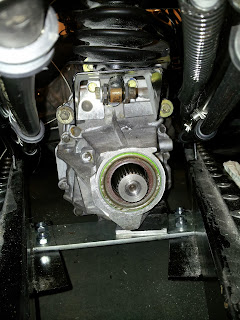Not having an engine crane, we had to improvise with two jacks, one under the sump on a large bit of wood to spread the load, and another jack and a bit of wood on the front edge of the block where there was just enough of the block showing to use as a jacking point. We did one side at a time, removed the long bolt through the engine mount and replaced with an even longer one as there wasn't any thread showing beyond the nut on the original Dax supplied bolts.
Pic above shows new nice long bolts with lots of thread. The threaded part of the bolt wasn't very long so had to pack out with a few thick washers. Put a bit of copper grease on the shank of the bolt and all was good.
For the height adjustment, the Internet is full of shim plates at $50 a pair but they are just a bit of steel of various thickness. The engine mount fixes in three positions to raised bosses in the block so we just packed a few washers in.
You can just see the stack of washers between the mount and the bosses on the block. When all was finished, the engine had been raised by almost 8mm. This has also improved the clearance of the clutch slave cylinder which has been an issue for a while. I have started making some shims from 6mm plate for the gearbox mount as the whole engine is sloping backwards by quite a bit, I think the gearbox needs to come up by 10-15mm or so.
Edited 20/9/2013
What we neglected to consider was that in raising the engine on the mounts, the engine/gearbox are now sloping downwards to the rear. For reasons that I'm not quite sure about the engine has to be level for the carb to work, and also to minimise wear on the prop shaft joints the output shaft of the gearbox needs to be reasonably in line with the differential (within 1 or 2 degrees).
I already knew before jacking the engine up that the output spline is 2deg off the diff input shaft, so now it would be even worse. Out of the garage, and into the workshop to rummage through my ever-more useful bin of scrap bits of metal. I found some likely looking bits of 6mm plate and set to work making some gearbox mount shims. The gearbox mount sits on a plate that goes across the centre of the chassis, with two M12 fixings on each side. This plate will be shimmed up a bit.
Diff end:
Gearbox end pre-shimmage:
Here's 12mm worth of shimmage (2 each side) having a bit of paint applied:
With these fitted the difference in angles of the gearbox and the diff was reduced to 0.7deg which seems entirely reasonable. The angle of the engine (measured on the machined face of the inlet manifold that the carb fits to) is 0.3deg sloping backwards (compared to the chassis to eliminate error from sloping garage floor). Apparently this is a good thing and will reduce the chances of stalling under heavy braking. Not entirely sure why though.






No comments:
Post a Comment